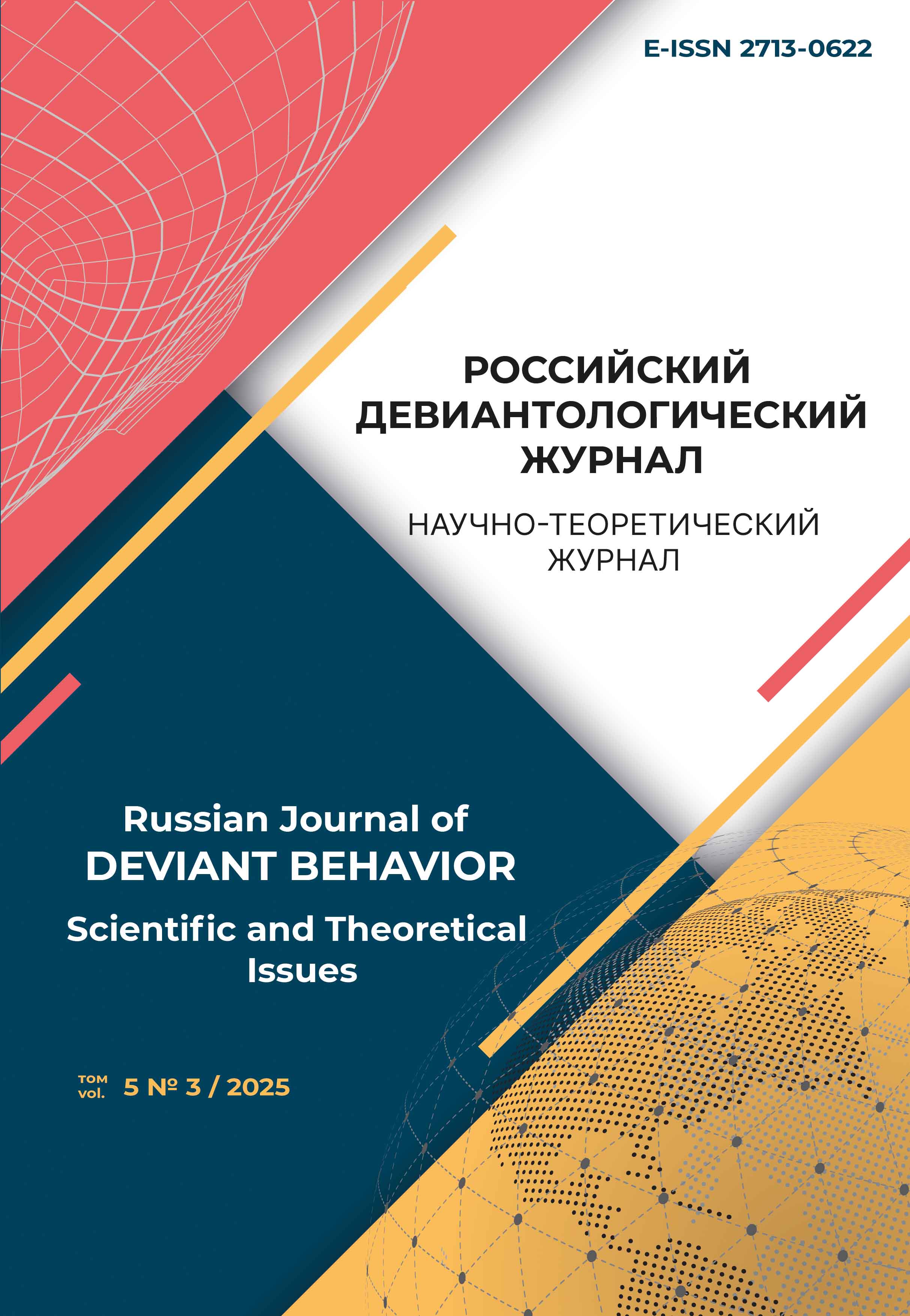Санкт-Петербург, Россия
УДК 159.9 Психология
ГРНТИ 15.81 Прикладная психология
ОКСО 37.00.00 Психологические науки
ББК 8 ФИЛОЛОГИЧЕСКИЕ НАУКИ. ХУДОЖЕСТВЕННАЯ ЛИТЕРАТУРА. ИСКУССТВО. РЕЛИГИЯ. ФИЛОСОФИЯ. ПСИХОЛОГИЯ
Введение. В статье рассматривается проблема переживания моральных эмоций вины, а также ее составляющих – совести и стыда – с позиции оценки риска рецидива преступления. Именно эмоции вины, совести и стыда могут представлять собой важнейший ресурс процесса ресоциализации в связи с их возможностью оказания влияния на ценностно-смысловой выбор постпенитенциарной личности. Методы. В статье применялись общенаучные методы исследования, направленные на сбор, анализ, систематизацию и обобщение данных, анализ нормативных правовых актов и литературных источников. Результаты. Рассмотрены существующие модели оценки риска рецидивов, позволяющие оценить, насколько вероятен риск совершения повторных правонарушений, и разработать программу ресоциализации постпенитенциарной личности. Отмечается, что в последние десятилетия наибольшую популярность приобрела модель RNR, которая основана на оценке риска и потребностей постпенитенциарной личности, доказала свою эффективность многочисленными исследованиями, проводимыми за рубежом. При этом в последнее время наблюдается тенденция учета сильных сторон (ресурсов личности), обусловленная влиянием разработок позитивной психологии. В связи с чем рассматриваются инструменты оценки риска рецидивов четырех поколений – от клинической оценки до профессионального структурированного суждения с учетом факторов риска, потребностей и сильных сторон. Анализируются особенности переживания вины, совести и стыда в представленных инструментах. Приводятся результаты зарубежного опыта, в которых установлена взаимосвязь вины, совести и стыда с совершаемыми преступлениями. Делается вывод о том, что в системе уголовных наказаний и пробации Российской Федерации возникает необходимость оценки риска рецидивов. При этом учет переживаний вины и ее составляющих – совести и стыда – позволит осуществить глубокую оценку постпенитенциарной личности и более эффективно выстроить программу ресоциализации.
вина, совесть, стыд, постпенитенциарная личность, оценка, риск, рецидив, преступление
1. Белик, И. А. (2006). Чувство вины в связи с особенностями развития личности: автореф. дис. … канд. психол. наук. Санкт-Петербург.
2. Макогон, И. К., Ениколопов, С. Н. (2015). Апробация методики измерения чувств вины и стыда (Test of self-conscious Affect-3 - TOSCA-3) Tangney J. P., Dearing R. L., Wagner P. E., Gramzow R. H. Теоретическая и экспериментальная психология, 1, 6–19.
3. Andrews, D. A., & Bonta, J. (1994). The psychology of criminal conduct. Cincinnati, OH: Anderson.
4. Andrews, D. A., & Bonta, J. (1995). The level of service inventory–revised. Toronto, Ontario, Canada: Multi-Health Systems.
5. Andrews, D. A., Bonta, J., & Wormith, J. S. (2011). The Risk-Need-Responsivity (RNR) mode: Does adding the good lives model contribute to effective crime prevention? Criminal Justice and Behavior, 38, 735–755.
6. Aragno, A. (2008). The language of empathy: An analysis of its constitution, development, and role in psychoanalytic listening. Journal of the American Psychoanalytic Association, 56, 713–740.
7. Brennan, T., Dieterich, W., & Ehret, B. (2009). Evaluating the predictive validity of the COMPAS risk and needs assessment system. Criminal Justice and Behavior, 36 (1), 21–40.
8. De Vries Robbé, M., de Vogel, V., & de Spa, E. (2011). Protective factors for violence risk in forensic psychiatric patients. A retrospective validation study of the SAPROF. International Journal of Forensic Mental Health, 10, 178–186.
9. De Vogel, V., de Vries Robbé, M. C., de Ruiter, Y., & Bouman, H. A. (2011). Assessing Protective Factors in Forensic Psychiatric Practice: Introducing the SAPROF. International Journal of Forensic Mental Health, 10 (3), 171–177.
10. Gendreau, P., Little, T., & Goggin, C. (1996). A meta-analysis of the predictors of adult offender recidivism: What works! Criminology, 3 (4), 575–607.
11. Harris, N. (2006). Reintegrative shaming, shame, and criminal justice. Journal of Social Issues, 62, 327–346.
12. Hosser, D., Windzio, M., & Greve, W. (2008). Guilt and shame as predictors of recidivism: A longitudinal study with young prisoners. Criminal Justice and Behavior, 35, 138–152.
13. Janda, L. H, & Bazemore, S. D. (2011). The Revised Mosher Sex-Guilt Scale: its psychometric properties and a proposed ten-item version. J Sex Res., 48 (4), 392–396.
14. Jolliffe, D., & Farrington, D. J. (2004). Empathy and offending: A systematic review and metaanalysis. Aggression and Violent Behavior, 9, 441–476.
15. Lickel, B., Schmader, T., Curtis, M., & Scarnier, M. (2005). Vicarious shame and guilt. Group Process. Intergroup Relat, 8, 145–147.
16. Looman, J., & Abracen, J. (2013). The Risk Need Responsivity model of offender rehabilitation: is there really a need for a paradigm shift? Correctional Service of Canada. International journal of behavioral consultation and therapy, 8, 3–4.
17. Nathanson, D. L. (1992). Shame and Pride: Affect, Sex, and the Birth of Self. New York: Norton.
18. Schalkwijk, F., Stams, G. J., Stegge, H., Dekker, J., & Peen, J. (2016). The conscience as a regulatory function: Empathy, shame, pride, guilt, and moral orientation in delinquent adolescents. International Journal of Offender Therapy and Comparative Criminology, 60 (6), 675–693.
19. Tangney, J. P. (1991). Moral affect: The good, the bad, and the ugly. Journal of Personality and Social Psychology, 61, 598–607.
20. Tangney, J. P., Miller, R. S., Flicker, L., & Barlow, D. H. (1996). Are shame, guilt and embarrassment distinct emotions? Journal of Personality and Social Psychology, 70, 1256–1269.
21. Tangney, J. P., & Stuewig, J. (2011). Shame, guilt and remorse: implications for offender populations. The Journal of Forensic Psychiatry & Psychology, 22 (5), 706–723.
22. Tangney, J. P., Stuewig, J., Mashek, D., & Hastings, M. (2011). Assessing Jail Inmates' Proneness To Shame and Guilt: Feeling Bad About the Behavior or the Self? Crim Justice Behav, 38 (7), 710–734.
23. Tibbetts, S. G. (2003). Self-conscious emotions and criminal offending. Psychological Reports, 93, 101–126.
24. Ullrich, S., & Coid, J. W. (2011). Protective factors for violence among released prisoners - Effects over time and interactions with static risk. Journal of Consulting Clinical Psychology, 79 (3), 381–390.
25. Van Langen, M. A. M., Wissink, I. B., van Vugt, E. S., van der Stouwe, T., & Stams, G. J. J. M. (2014). The relation between empathy and offending: A meta-analysis. Aggression and Violent Behavior, 19, 179–189.
26. Ward, T., & Stewart, C. A. (2003). The treatment of sex offenders: Risk management and good lives. Professional Psychology: Research and Practice, 34, 353–360.
27. Ward, T., Yates, P., & Willis, G. (2012). The good lives model and the risk need responsivity model: A critical response to Andrews, Bonta, and Wormith. Criminal Justice and Behavior, 39, 94–110.
28. Webster, C. D., Martin, M., Brink, J., Nicholls, T. L., & Desmarais, S. L. (2009). Manual for the Short Term Assessment of Risk and Treatability (START) (Version 1.1). Coquitlam, Canada: British Columbia Mental Health & Addiction Services.
29. Wilson, C. M., Desmarais, S. L., Nicholls, T. L., & Brink, J. (2010). The role of client strengths in assessments of violence risk using the Short-Term Assessment of Risk and Treatability (START). The International Journal of Forensic Mental Health, 9, 282–293.














